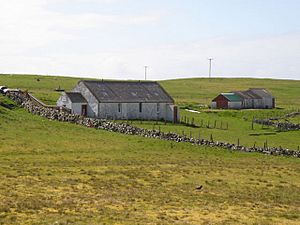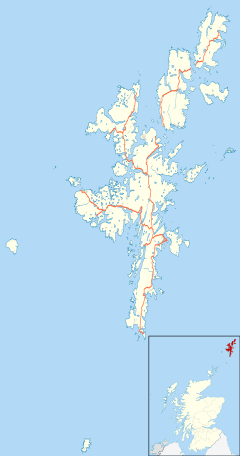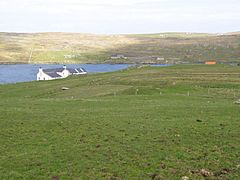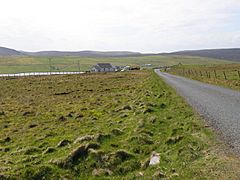Gruting facts for kids
Quick facts for kids Gruting |
|
|---|---|
 Gruting Methodist Church |
|
| OS grid reference | HU278493 |
| Civil parish |
|
| Council area | |
| Lieutenancy area | |
| Country | Scotland |
| Sovereign state | United Kingdom |
| Post town | SHETLAND |
| Postcode district | ZE2 |
| Dialling code | 01595 |
| Police | Northern |
| Fire | Highlands and Islands |
| Ambulance | Scottish |
| EU Parliament | Scotland |
| UK Parliament |
|
| Scottish Parliament |
|
Gruting is a small village, also called a hamlet, located on the island of Mainland. This island is part of Shetland, a group of islands in Scotland. Gruting is found about 1 kilometer (about half a mile) southwest of an important ancient place called Stanydale Temple.
Contents
Gruting's Ancient Past
Gruting has a very long history! Scientists have found signs of people living here a very long time ago, during the late Neolithic period. The Neolithic period is also known as the New Stone Age. It was a time when humans started farming and building more permanent homes.
Farming in the Stone Age
At a place called Ness of Grutling, archaeologists (people who study ancient times) discovered burnt barley. Finding burnt barley tells us that people were growing crops and cooking them here thousands of years ago. It shows that farming was an important part of their lives.
An area of about 3.3 hectares (which is about the size of five football fields) shows clear signs of ancient farming. People in the Neolithic period had to clear many stones from their fields to grow crops. They piled these stones up, and about fifty of these stone piles can still be seen today! This shows how much effort they put into farming their land.
Dating Ancient Discoveries
The burnt barley found at Gruting is incredibly old. Scientists used a method called radiocarbon dating to figure out its age. This method helps them tell how old ancient objects are. The barley was found to be from around 1564 BC. That means it is over 3,500 years old!
Ancient Connections
Pottery found at Ness of Grutling looks similar to pottery from the Hebrides, another group of islands in Scotland. This suggests that the people living in Gruting long ago might have traded or had contact with people from other parts of Scotland. They weren't isolated; they were part of a wider network of communities.
Archaeologists also found special tools made from a type of rock called porphyry. These tools were split into flakes and were likely used for skinning animals. This tells us more about how people lived and what skills they had during the Stone Age.
Gallery




